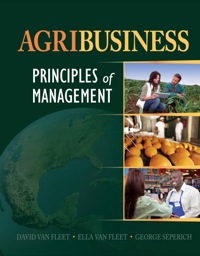The agribusiness industry is remarkably productive; however, this productivity comes with a price. The United States produces
Question:
The agribusiness industry is remarkably productive; however, this productivity comes with a price. The
United States produces about 591 billion pounds of food each year, and up to half goes to waste. This does
not occur in one place or venue; everyone contributes: harvesting leaves 10 to 15 percent of a crop in the
field, the transit of food loses another 10 to 15 percent, supermarkets dispose of 30 million pounds of food a
day, the average shopper throws away 15 to 25 percent of the food she buys, commercial kitchens (hospitals,
schools, etc.) dispose of another 4 to 10 percent, and restaurants discard around 10 percent of the food they
purchase. Most of this wasted food ends up in landfills; only about 2.5 percent is composted. You might
think the business to pursue is trash collecting. After all, someone must haul away all of this food.
However, David Steiner, CEO, Waste Management Inc., would disagree. In fact, he thinks the future
of a traditional garbage-collection company looks bleak. “Picking up and disposing of people’s waste is not
going to be the way this company survives long term.” Everywhere he looks he sees threats to his business:
reusable grocery bags, concentrated laundry detergent in small packages, and Walmart embracing the idea
of zero waste.
Walmart? As the world’s largest retailer, Walmart is on a mission to determine the social and environmental
impact of every item it puts on its shelves. It wants to create a universal rating system that scores
products based on how environmentally and socially sustainable the products are over the course of their
lives. This is the green equivalent to a food product’s nutrition label. The company is looking to academics
for help. People such as Jon Johnson at Sam M. Walton College of Business at the University of Arkansas and
Jay Golden at Arizona State University have joined the fray.
“Because of Walmart’s leadership . . . they were able to set a standard for the entire industry,” said Len
Saucers, vice-president, customer development at Unilever. “Walmart has invited the Targets, the Costco’s
and the Tesco’s of the world to come up with a solution . . .” said Tim Marin, associate director of external
relations, Procter & Gamble.
“We know we need to get ready for a world in which energy will only be more expensive,” explained
Michael T. Duke, CEO, Walmart. Its goal is to cut 20 million metric tons of greenhouse gas emissions from its
supply chain by the end of 2015. This is the equivalent to removing 3.8 million cars from the road for a year.
This is a major reason why Waste Management is looking for ways to extract value—energy or
materials—from the waste stream. “Think Green,” is Waste Management’s new tag line. It is more than
a line. The company is trying to communicate a new direction to its stakeholders. It has invested in or
acquired nearly 25 companies that capture materials or energy from stuff that’s thrown away. Already Waste
Management’s waste-to-energy plants generate enough electricity to power 1.1 million homes—more than
the entire solar energy industry can generate in the United States.
While most yard clippings are recycled, more than 95 percent of food waste goes to landfills. The cost
of transporting this heavier and wetter waste exceeds whatever revenues can be realized from turning it
into fertilizer or compost. “Organics, for us, is difficult, but it’s also a huge opportunity,” CEO Steiner says.
Turning a ton of food waste into compost generates about $40 to $50 in revenue. Generating transportation
fuels, like gasoline, from a ton of food waste could generate $200 to $250 in revenues. “If we can figure out
a way to process and convert organic material better than anybody else, we’re going to own that material,”
challenged Steiner.
Speaking of trash, there is some noise in the system. Frito-Lay, the maker of Sun Chips, thought it was
onto a great idea—a healthy snack food in a 100 percent biodegradable chip package. The biodegradable
bag, polylactic acid to chemists, will disappear in 14 weeks while a conventional potato chip bag takes over 100 years to degrade in a landfill. Great idea, great product, great . . . noise?
QUESTIONS
1. What elements of the communication model are most evident in this case?
2. What forms of communication are evident in this case?
3. How should organizations communicate their efforts to “go green” to stakeholders?
Step by Step Answer:

Agribusiness Principles Of Management
ISBN: 9781285952352,9781285947839
1st Edition
Authors: David Van Fleet, Ella Van Fleet, George J. Seperich





